By Anjum Choudhry Nayyar
 Alright moms, I think it’s high time South Asian cuisine sheds its image of unhealthy, high-cholesterol causing food don’t you? When most of us sit down to eat or cook a meal, we usually don’t think about the antioxidant value of a plate of food but what if you could make Indian food that isn’t only delicious but also good for you? That’s the premise of Indian SuperFood, a book written by 34-year-old Gurpareet Bains, a nutritional therapist and chef as well as the world’s leading expert on Indian Superfood, a culinary concept which he created.
Alright moms, I think it’s high time South Asian cuisine sheds its image of unhealthy, high-cholesterol causing food don’t you? When most of us sit down to eat or cook a meal, we usually don’t think about the antioxidant value of a plate of food but what if you could make Indian food that isn’t only delicious but also good for you? That’s the premise of Indian SuperFood, a book written by 34-year-old Gurpareet Bains, a nutritional therapist and chef as well as the world’s leading expert on Indian Superfood, a culinary concept which he created.
Bains first came on the international spotlight in 2009, when he created the ‘world’s healthiest meal’ – a simple Chicken Curry with Blueberries and Goji Berry Pilau – which contained the antioxidant-equivalent of 23 bunches of grapes.
(CHECK OUT OUR MIRCH MASALA SECTION FOR THIS RECIPE!)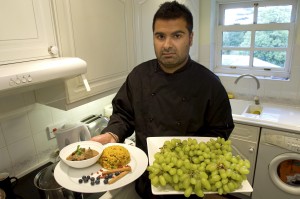
His celebrity fans include Their Royal Highnesses the Duke and Duchess of Gloucester, Goldie Hawn, Dame Vivienne Westwood, Chris Evans, Sanjeev Bhaskar OBE, Meera Syal MBE, as well, as celebrity chefs Ching-He Huang, Vicky Bhogal and Mark Diacono.
His distinctive culinary concept acknowledges the USDA finding that nearly ¼ of the top antioxidant-rich foods available to us are, in fact, spices. He combines these spices in abundance with nutrient-dense vegetables, fruits, low-fat proteins and nuts – widely known as super foods – to create Indian Superfood, a collection of the world’s most ant oxidising recipes. The book is truly a crash course on healthy Indian food.
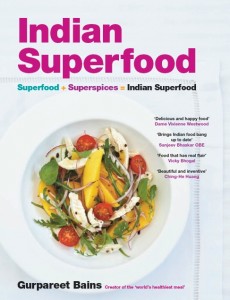 He spoke to masalamommas about his book and some his favourite super foods. CLICK HERE FOR A PODCAST.
He spoke to masalamommas about his book and some his favourite super foods. CLICK HERE FOR A PODCAST.
What is Indian SuperFood?
“It’s where we recognize that certain foods that are healthier for you and have an added nutritional benefit. They’re rich in fatty acids, vitamins and antioxidants. It recognizes super food and also recognizes spices for being the most antioxidizing foods on the planet and it brings two groups of foods together in one cuisine which is called Indian Super Food. Some people will say how’s that different from Indian food? Well, in Indian food, we wouldn’t necessarily two tablespoons of cinnamon in a curry, so there’s an adjustment in the way we use spices it’s a way of cooking super food and Indian food to benefit our health.
What’s an example of Indian Superfood that we may not know about?
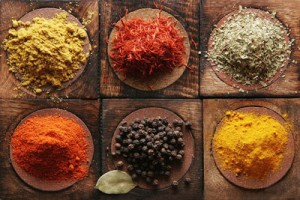 Cinnamon: just by taking a teaspoon a day you can reduce blood sugar levels in people suffering from diabetes. Turmeric can be applied directly to wounds to help them heal. In India for example you can buy a band aid with turmeric already on it.
Cinnamon: just by taking a teaspoon a day you can reduce blood sugar levels in people suffering from diabetes. Turmeric can be applied directly to wounds to help them heal. In India for example you can buy a band aid with turmeric already on it.
Coriander is amazing as well. Research from the a university in Iran showed that coriander can relieve anxiety and under lab tests, the extract has proven to have an anti-anxiety effect as well as being a muscle relaxant and sedative. Every spice has antibacterial, analgesic and anti-inflammatory effect in the body. It is the dried spices that have a potent amount of antioxidants in them. That’s why we call them garam (or hot). Often we’re told that if you heat food you lose the nutrients, but with spices it’s the opposite effect.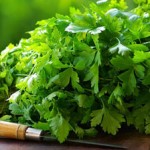
What’s one of your favourite recipes in your book?
I love my dry fruit & nut balls recipe; it’s similar to halva.
75g of unsalted cashews
1/4 teaspoon of ground ginger or ground cinnamon
85g of pitted dried dates (chopped)
50g of dried cranberries
30 g of dried Gogi berries (contain up 500x times more vitamin C than oranges)
Put cashews, ground ginger/cinnamon and grind them into food processor until cashews look like bread crumbs, add dried fruits in food processor until the mixture looks like a paste (you can start with 15mls of cold water)
Eventually you’ll have a sticky ball, divide into 8 portions, roll them into balls, and roll each one in sesame seeds and voila you have a very healthy Indian dessert and your very Indian aunty doesn’t need to know how healthy it really is.
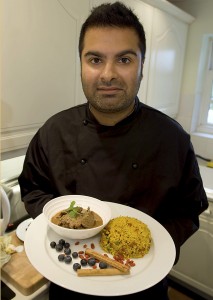 What’s your favourite Superfood?
What’s your favourite Superfood?
One of my favourite foods is exotic mushrooms, like oyster mushrooms etc. these mushrooms contain better glucane which is found to better stimulate the immune system. They have an anti-viral anti-cancer effect in the body. What I find is when you cook them into curry, they are so soft and creamy and tasty. Cinnamon is also a favourite of mine and played a key part when I created the world’s healthiest meal. US department of agriculture have said that Cinnamon contains 300,000 antioxidant units per 100g of cinnamon and you can pair it up with grapes which contains 1000 units of antioxidants units per 100g of cinnamon.
Who would benefit most from reading the book?
Someone who wants to cook food quickly and those who want to improve their health. Those who want to be cool, and make their Indian food cool.
Can you describe some Superfoods that are beneficial to women’s health?
Greek yogurt (the low fat kind), it’s higher in calcium and one serving of this yogurt will give you nearly ¼ of a woman’s calcium needs. It’s high in probiotics as well. Women also love chocolate and dark chocolate is a superfood. Dark chocolate is loaded with magnesium, manganese, cooper, zinc, phosphorous which are all important for bone development and it’s very high in antioxidants as well. Another superfood I love is quinoa, and you can just cook it with peas and cumin and it’s very rich in minerals and is a great source of PMS fighting manganese. Its’ the closest you can get in the vegetable world to meat.
Indian SuperFood is available at most bookstores and Amazon.com.
For more information on Gurpareet Bains and Indian SuperFood visit: www.gurpareetbains.co.uk/indian_superfood
His debut recipe book, Indian Superfood, was published by Absolute Press in July, 2010.
Gurpareet has been featured in nearly every major newspaper in the UK and India, in addition to receiving coverage from the ABC, BBC & CNN. He is a regular contributor to the BBC Asian Network and the Sunday Times.
Gurpareet has worked as a chef for the Mövenpick Hotel. He is based in London and Los Angeles.
Goji Berry and Green Pea Pilau
Serves 4
This is pretty much the basic pilau recipe my Mum fed me on from a young age. It was how I thought all rice was made until I was much older. In fact, Punjabis possess a queer snobbery for their pilau recipe. Rather peculiar, considering we have never been the traditional connoisseurs of rice. I remember my grandmother was once served plain boiled rice. She threw it back at her servants, saying that boiled rice was for the labourers and not for her. Even my Mum would ‘snarl’ at rice cooked in any other way than the traditional Punjabi method, saying the pure white grains of boiled rice would remind her of teeth and, therefore, put her off her dinner.
For a people who rarely eat rice, the Punjabi obsession with their pilau is nothing short of baffling. But, once you experience its multifaceted flavours, you will be able to appreciate, just a little, where the burning passion takes root from. Like most of their foods, it’s very satisfying indeed; enough so that you can even enjoy it by itself with just a knob of butter or a dollop of natural yogurt.
I remember it was the first rice dish I taught myself to cook when leaving home. It took me years to get it right, so, I thought I’d share it with you. You can also throw in a few black cardamom pods for added depth of flavour – I remember Mum doing so on special occasions. The superfood twist is brought into full swing with the inclusion of ruby-coloured goji berries which add loads of vitamin C, as well as a wonderful and slightly fruity, almost tea like flavour.
1 tablespoon olive oil
1 heaped teaspoon cumin seeds
1 small onion, thinly sliced
1 carrot, grated
1 cup basmati rice
½ teaspoon salt, or to taste
a small handful of dried goji berries
a handful of green peas (fresh or frozen)
1) Pour the olive oil into a deep saucepan, add and cumin seeds and cook over a low-medium heat until the seeds begin to pop – this should take no more than 2–3 minutes. Add the onion and cook until it is soft, stirring frequently – this should take no more than 5 minutes. As soon as the onion is soft, add the carrot and cook for 2–3 minutes, stirring frequently.
2) Place the onion mixture, rice, salt and 1 ¾ cup boiling water into a large microwave safe bowl and mix with a fork.
3) Microwave, uncovered, for 4 minutes on HIGH at 700W, or for 31/2 minutes on HIGH at 800W or for 3 minutes on HIGH at 900W.
4) Mix with a fork. Microwave, uncovered, for a further 4 minutes on HIGH at 700W, or for a further 31/2 minutes on HIGH at 800W, or for a further 3 minutes on HIGH at 900W.
5) Mix with a fork. Cover the bowl and microwave for a further 4 minutes on HIGH at 700W, or for a further 31/2 minutes on HIGH at 800W, or for a further 3 minutes on HIGH at 900W.
6) Take the pilau out of the microwave, add the goji berries and peas on top of the rice and leave it to stand, covered, for 10 minutes.
7) Fluff the rice with a fork and serve.


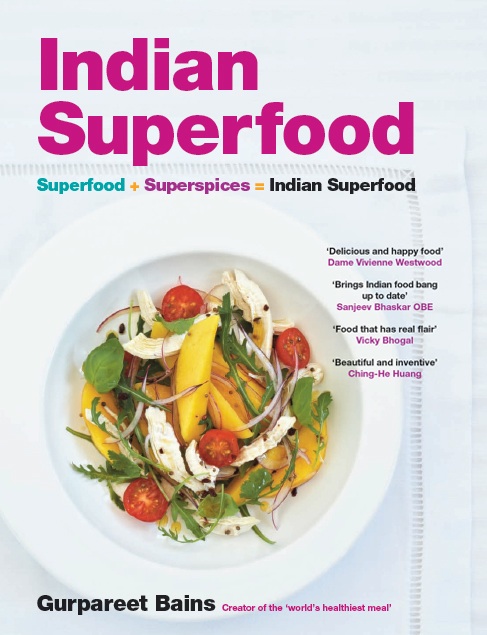


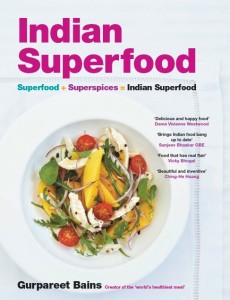
[…] more information on Gurpareet Bains and his book, Indian Superfood, click here for our story. Did you like this? Share it:Tweet 0 Comments – Leave a comment! « […]
This book sounds amazing! I am constantly looking for Indian recipes that are not only good for you but tasty too. I will definitely try the Goji Berry and Green Pea Pilau recipe. P.S. I just “liked” you on FB too!
thx sandy! you’re in the draw! will keep you posted!